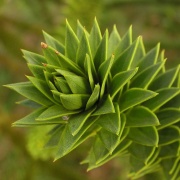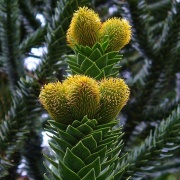Araucaria araucana
Contents
Common Names
Monkey Puzzle, Chilean Pine
Family
Description
A fine evergreen specimen with sharp green triangular leaves, green bark, open habit; an interesting garden tree.
File:201 E.jpg fruit |
File:201 F.jpg nut |
|
| Foliage | evergreen |
| Group | conifer |
| Toxic Parts? | no |
| Height | 15 - 25m |
| Crown Diameter | 12m |
| Crown Shape | pyramidal |
| Shade Tree? | no |
| Autumn Colour? | no |
| Age | 50-1000 years |
| Time to Maturity | 90 - 100 years |
| Flower Colour | green |
| Fruit Colour | brown |
| Bee Friendly? | - |
Native Areas
It's found in the lower slopes of the Chilean and Argentinian south-central Andes, typically above 1,000 metres (3,300 ft)[1].
Preferred growing conditions
| Soil pH Range | 5.5 - 8 (slightly acidic - neutral - slightly alkaline ) |
| Soil Types | sand, silt, clay, loam, chalk |
| Drainage | well drained |
| Soil Fertility | medium |
| Sunshine | part sun and full sun |
| Soil Moisture | normal |
| Tolerates Exposure | no |
| Growth Rate | - medium |
Hardiness
| RHS | USDA | EGF |
| H | 7B | H1 |
How to plant
Water container-grown and rootballed trees well and allow to drain an hour before planting. While it drains dig out an area for the tree that is about 2 to 3 times the diameter of the container or rootball and the same depth as the container or rootball. If the soil is compacted loosen with a fork (this includes the sides of the hole). But beware of having soil that is too loose on the bottom as this will cause the tree to be lower than desired upon watering.
- If container-grown, put the tree on its side and remove the container. Place in the hole and loosen the roots around the edges without breaking up the root ball too much. Check the depth by place a cane or stick across the diameter - only the root collar should be below and not the main stem.
- If planting a balled and burlapped tree, remove ties or nails from the burlap at the top of the ball and using a knife if necessary, pull the top of the burlap back, so it does not stick out of the hole when the soil is replaced. Synthetic burlap should be completely removed as it will not decompose. Note burlap sticking out of the hole can wick water away from the tree.
- For bareroot trees, feel the moisture of the roots by hand - if dry, dunk them in an bucket of water for 10-15 seconds and replace the packaging (if you are not going to plant at that time). Do not plant too deeply - only plant up to the root collar. i.e. the stem should not be covered in soil. Ensure roots are planted firmly and have good contact with the soil.
Fill in the hole with soil and compost, but do not add less than half of the original soil.
Using the soil, create a water ring around the outer edge of the hole. Not only does this conserve water, but it will also direct moisture to the perimeter roots, encouraging outer growth. Once the tree is established, the water ring may be levelled. Studies show that mulched trees grow faster than those unmulched, so add a 3 inch layer of pinestraw, compost, or pulverized bark over backfilled area.
Only prune lower damaged branches if necessary. Water newly planted trees regularly in their first year. Staking is also important in new trees and in exposed areas - a 1 m stake at 45 degrees crossing the stem at a height of 15 cm can provide good support. Be careful of the binding of the stake to ensure the tree is not strangled. Binding should be checked in the second year, as the stem will thicken.
When to plant
Early to mid-Autumn, for cold, wet sites wait until early to mid-Spring. Container-grown trees can generally be planted all year round except when it is very hot and dry or the ground is frozen.
Tree care
| Hedging Potential | no |
| Balcony/Roof Terrace | no |
| Indoors | no |
Potential Pests and Diseases
| Pests | |
| Diseases |
Ecology
History and Human Connection
First found in Chile in the 1780s, it was named Pinus araucana by Molina in 1782. In 1789, de Jussieu had erected a new genus called Araucaria based on the species, and in 1797 Pavón published a new description of the species which he called Araucaria imbricata (an invalid name, as it did not use Molina's older species epithet). Finally in 1873, after several further redescriptions, Koch published the combination Araucaria araucana, validating Molina's name in the genus. The name araucana is derived from the native Araucanians who used the nuts (seeds) of the tree in Chile. A group of Araucanians living in the Andes, the Pehuenches, owe their name to their diet based on harvesting of the Araucaria seeds. Pehuen means Araucaria and che people in Mapudungun[1]. In Britain before 1850, it had been known as "Joseph Banks Pine" or "Chile Pine". In 1840 William Lobb collected 3000 seeds from Araucaria araucana from the Andes. He dispatched the seeds to Veitch and Sons and by 1843 the first seedlings were on sale[2]. The origin of the popular English language name monkey puzzle derives from its early cultivation in Britain in about 1850, when the species was still very rare in gardens and not widely known. The proud owner of a young specimen at Pencarrow garden near Bodmin in Cornwall was showing it to a group of friends, and one made the remark "It would puzzle a monkey to climb that"; as the species had no existing popular name, first 'monkey puzzler', then 'monkey puzzle' stuck [1]. In France it is known as désespoir des singes or 'monkeys' despair'.
Uses
- As a popular ornamental, it is grown in nearly every botanical garden in Europe. Yet in its native habitat it is threatened with extinction [2].
- The nuts are harvested extensively in Chile
References




